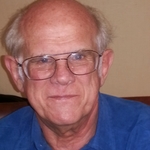John Trenholme

John Trenholme died Nov. 23. He was 81.
John Trenholme, a pioneer in laser physics who left a lasting impact on the field, passed away from a rare neurological illness on Nov. 23, 2020. He was 81.
Much of Trenholme’s work came to fruition in the National Ignition Facility at Lawrence Livermore National Laboratory, where his years of basic research yielded mathematical descriptions of fundamental optical physics, nonlinear optics and optimized system designs capable of delivering the requested performance of the world’s largest and most energetic laser.
Tenholme was born in Eugene, Oregon, to Edward Curtis Trenholme and Jessie Alice Trenholme. As a child, he loved science, especially physics. Upon graduating from high school, he received a National Merit Scholarship that enabled him to study at the California Institute of Technology, where he earned his bachelor’s, master’s and Ph.D. degrees.
During graduate school, he spent a year working in India to set up a low-temperature laboratory at the Indian Institute of Technology. John’s wife Keren describes this as a deeply meaningful experience that changed how he viewed the world and his relationship with other people. After India, John journeyed around the world before returning to Cal Tech. He enjoyed meeting people and developed an understanding of the complexities of other cultures.
In 1972, John joined LLNL. His collaboration with Ken Jancaitis and Geoffroy Le Touzé led to the ray-tracing code AMP 3D, used to design the pump cavities for both NIF and Laser Mégajoule in France. He created CHAINOP, a Visual Basic optimization code used to sift through hundreds of thousands of alternative configurations, leading finally to selection of the multi-pass laser architecture now seen in NIF.
John also made significant contributions in the study of optical damage. He wrote Equivinit, a small piece of code now subsumed within LPOM that provides a common basis for predicting damage initiation, regardless of the pulse shape of a potentially damaging beam.
Beyond his scientific contributions, John was also a leader and mentor for multiple generations of laser physicists, modelers, and engineers.
He is survived by his wife, Keren; his son Samuel Trenholme; Samuel’s daughter, Citlalli Trenholme; Keren’s daughter, Ellen Perling Skinner, and grandchildren Sarah and David Perling; his stepchildren from his first marriage, Judy Hazen and Jim Long; and his sister, Alice Isaacman, and brother, Peter Trenholme.
A celebration of his life will be held at a future date. Contributions in Trenholme’s memory can be sent to the Wikimedia Foundation, the Internet Archive, and the Food Bank of Contra Costa and Solano County.
Remembrances may be sent to Mark Herrmann at LLNL: Herrmann9 [at] llnl.gov




